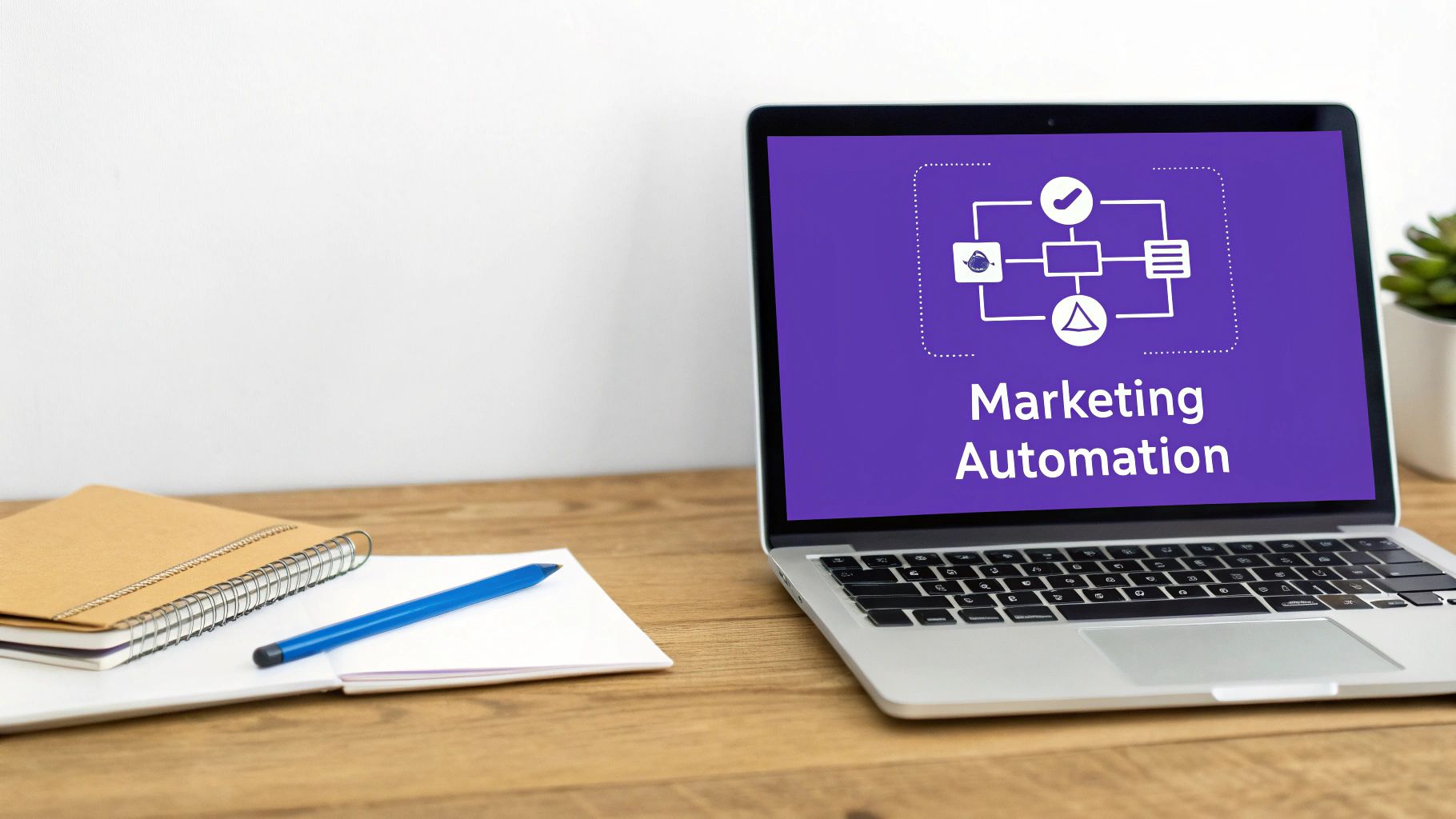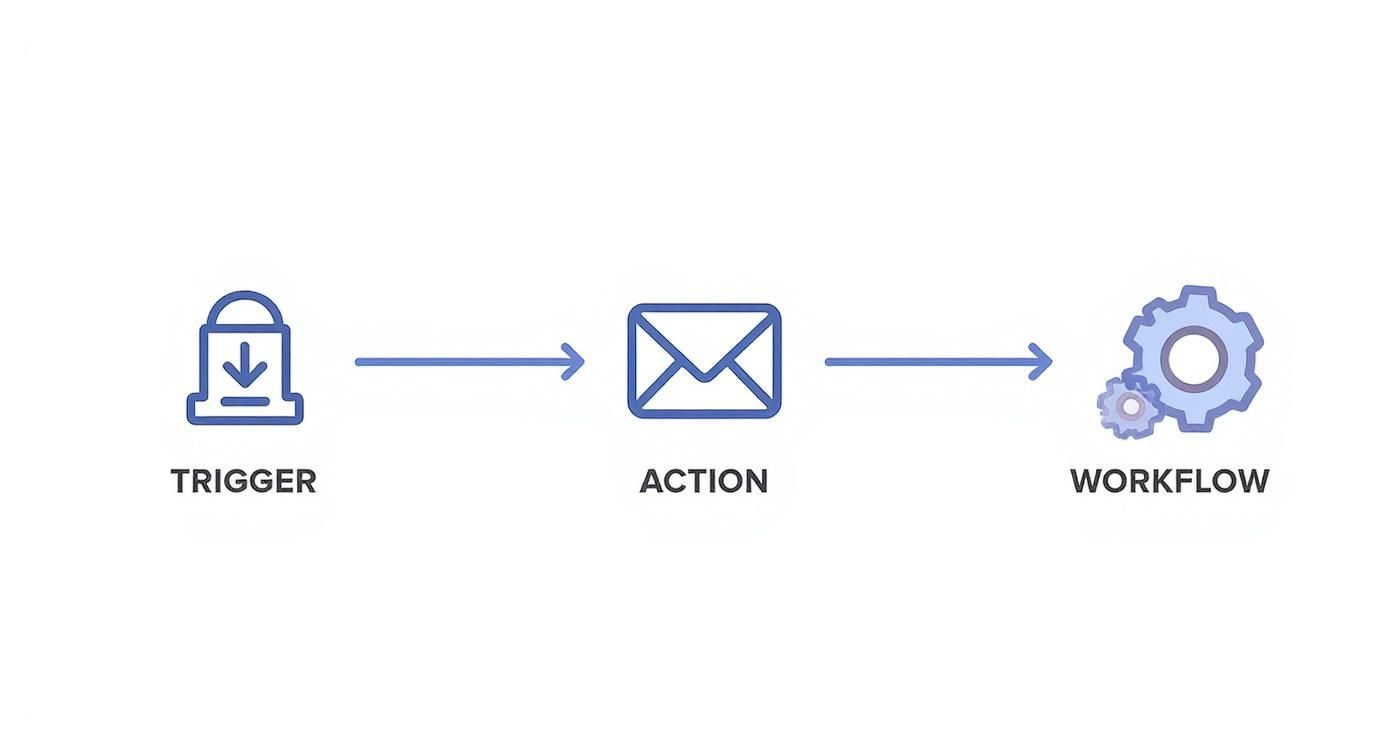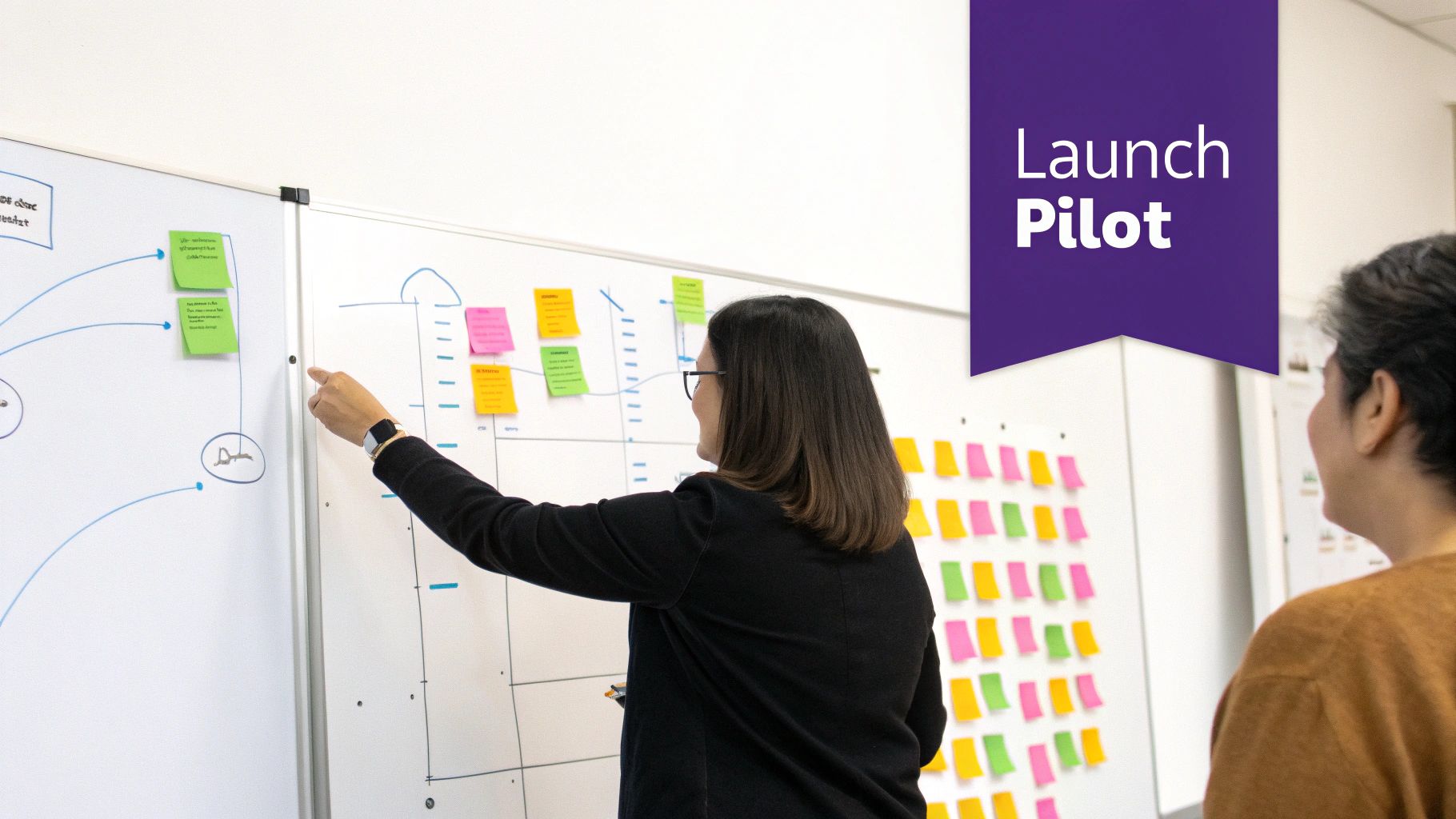Marketing automation is all about using software to handle your marketing tasks automatically. At its best, it allows businesses to scale personalized conversations, build stronger relationships with potential customers, and guide them smoothly from their first flicker of interest to a final purchase. According to recent studies, businesses using automation see a 451% increase in qualified leads, showcasing its immense potential for growth.
Understanding Marketing Automation At Its Core

Think of marketing automation as a smart, tireless digital assistant for your marketing team. It expertly takes care of the repetitive but vital jobs—like sending follow-up emails, posting on social media, or updating customer records. This frees up your human team to focus on the big-picture strategy and creative work that really moves the needle.
But this isn't just about scheduling emails in advance. It’s about building a responsive system that reacts to what a customer actually does in real time.
The real goal here is to nurture leads with highly personalized, genuinely useful content that helps them solve their problems. When a potential customer downloads an e-book or lingers on your pricing page, the system can automatically send them relevant follow-up information. For the buyer, it feels like a seamless and helpful experience. For your team, it's a far more efficient process.
Triggers, Actions, and Workflows
At its heart, marketing automation runs on a simple but incredibly powerful logic built from three key components:
- Triggers: These are the specific customer behaviours or data points that kick off an automated process. Think of a user submitting a form, clicking a link in an email, or staying on a webpage for a certain amount of time.
- Actions: Once a trigger is pulled, the software performs a predefined action. This could be anything from sending a targeted email, adding the user to a specific list, alerting a sales rep, or assigning them a lead score.
- Workflows: A workflow is the sequence of these triggers and actions, all strung together. It’s the strategic map you design to guide a potential customer through their journey, making sure they get the right message at exactly the right moment.
Marketing automation done right is about one thing: delivering the right message to the right person at the right time. It turns marketing from a series of disjointed campaigns into a connected, intelligent conversation that builds trust and drives revenue.
The proof is in the numbers. Companies that excel at lead nurturing generate 50% more sales-ready leads at a 33% lower cost. This really highlights the significant return you can get when automation is used strategically. It gives even small teams the power to compete by scaling their ability to build meaningful relationships.
To clear up some common confusion, it helps to look at what marketing automation is—and what it isn't.
Marketing Automation Is vs Is Not
| What Marketing Automation Is | What Marketing Automation Is Not |
|---|---|
| A strategic system for nurturing leads over time | Just a tool for blasting out mass emails |
| A way to personalize communication at a massive scale | A replacement for human marketers and their creative input |
| A powerful tool for aligning your sales and marketing teams | A "set it and forget it" solution that runs itself |
| A data-driven method for optimizing every part of your funnel | Something that's only for large, enterprise-level companies |
Getting this distinction right is the first step toward building a strategy that actually works.
Are you ready to see how a strategic approach to automation can drive measurable growth for your business? Contact us to explore how our fractional CMO-led services can help.
How Marketing Automation Actually Works
At its heart, marketing automation runs on a simple but powerful principle: if this happens, then do that. This "if/then" logic is the engine that transforms static campaigns into a responsive system that engages potential customers based on what they actually do. It all starts with a trigger.
A trigger is just a specific action someone takes that your system is set up to notice. It could be a prospect downloading an e-book, a new subscriber signing up for your newsletter, or a lead visiting your pricing page for the third time this week. Each trigger is a signal of interest, a cue that this person is ready for the next step.
Once a trigger fires, it kicks off a pre-planned sequence of actions. This sequence, known as a workflow, is the strategic path you build to guide a potential customer forward. For instance, an e-book download could trigger a workflow that immediately sends a "thank you" email with the content. A few days later, it might send a follow-up email with a related case study. If they click that link, the system could then notify a sales rep that the lead is warming up.
The Power of Personalization at Scale
This is where marketing automation really proves its worth—by making personalized communication scalable. Instead of blasting the same generic message to your entire list, you can deliver highly relevant content that reflects a user's behaviour. And that personal touch makes a huge difference; research shows that 80% of consumers are more likely to buy from a brand that provides personalized experiences.
Let's walk through a common B2B example:
- Scenario: A user signs up for a free 14-day trial of your SaaS product.
- Trigger: The "Free Trial" form is submitted.
- Workflow:
- Action 1 (Immediate): Send a welcome email with their login details and a link to a "getting started" video.
- Action 2 (Day 3): Send another email highlighting a key feature, maybe based on information they provided during sign-up.
- Action 3 (Day 7): The system checks if the user has completed a key action (e.g., created their first project). If not, it sends a helpful tip or offers a short demo call.
- Action 4 (Day 12): Send a final reminder that their trial is ending, showcasing a customer success story to reinforce the value.
This entire sequence runs on its own, ensuring every new trial user gets a consistent, helpful onboarding experience designed to guide them toward conversion—all without your team lifting a finger.
A global healthcare enterprise successfully used marketing automation to align its team of 10,000 sellers with marketing efforts. This ensured that every account was engaged with the right message in the right context, turning a massive, complex sales process into a series of coordinated, personal conversations.
Advanced Concepts That Drive Results
Beyond basic workflows, a few key components elevate marketing automation from a simple tool into a strategic growth engine.
-
Segmentation: This is all about dividing your audience into smaller groups based on shared traits like job title, industry, company size, or past behaviour. Segmentation allows you to send super-targeted messages that resonate far more than any one-size-fits-all approach ever could.
-
Lead Scoring: This process automatically assigns points to leads based on their profile and actions (e.g., +10 points for visiting the pricing page, +20 for requesting a demo). Once a lead hits a certain score, they’re flagged as "sales-ready" and passed to the sales team, ensuring reps focus their time on the hottest prospects.
-
Dynamic Content: This clever feature lets you change parts of an email or landing page based on who is looking at it. For example, a contact from a manufacturing company could see a case study relevant to their industry, while a tech startup sees a different one—all within the same email campaign.
By combining triggers, workflows, segmentation, and lead scoring, you build an intelligent system that not only saves time but also creates genuinely better experiences for your future customers.
Ready to see how these concepts can be applied to build a revenue-driving engine for your business? Contact us for a consultation, and let's explore a tailored automation strategy together.
The Tangible Benefits For B2B Businesses
Getting started with marketing automation isn’t about chasing the latest tech trend; it’s about driving real, measurable business results. For B2B companies, the payoff goes way beyond simple efficiency. It can fundamentally reshape how you find, engage, and convert leads into loyal customers.
This infographic breaks down the core process: a prospect takes an action, and that single trigger kicks off a whole series of automated, personalized steps in a workflow.

Each step is a deliberate touchpoint designed to guide that person forward. It’s proof that automation, when done right, is all about creating a connected and thoughtful customer journey.
Drastically Increase Sales-Ready Leads
One of the biggest wins from automation is perfecting your lead nurturing. Instead of tossing every new contact over to the sales team, the system automatically warms them up. It sends relevant content, educational materials, and targeted messages based on their actual behaviour.
This methodical process ensures that by the time a lead talks to your sales team, they’re far more educated and genuinely interested. The impact is huge: companies that excel at lead nurturing generate 50% more sales-ready leads at a 33% lower cost. This means your sales reps can stop chasing cold contacts and spend their time on conversations with the highest odds of success.
Enhance Productivity and Efficiency
Let’s be honest, repetitive manual tasks are a massive drain on any marketing team. Think about all the hours spent sending one-off follow-up emails, updating CRM records, or segmenting lists for every new campaign. Marketing automation handles all of that with machine-like precision.
This frees up your team to focus on the high-value work—the strategic stuff like campaign planning, creative development, and deep-dive performance analysis. By putting routine tasks on autopilot, businesses have seen an average 14.5% increase in sales productivity. Those saved hours translate directly into activities that generate revenue.
Unlock Deep Customer Insights
Beyond just doing the work, marketing automation platforms are incredible data hubs. They track every single interaction a prospect has with your brand—every email opened, link clicked, and webpage visited. This builds a detailed digital footprint for every contact in your database.
By analyzing this behavioural data, you can uncover what your customers truly care about, which marketing channels are actually working, and where people are getting stuck in your sales funnel. This data-driven approach lets you stop guessing and start making smarter, more informed decisions.
This is especially true for businesses here in Canada. The marketing automation market in Canada is projected to grow at a CAGR of 14.9% between 2025 and 2030, with small and mid-sized businesses leading the charge. Government initiatives like the Canada Digital Adoption Program (CDAP) are even helping fund this shift, showing a strong national belief in automation's power to boost customer engagement and efficiency. You can discover more insights about the Canadian marketing automation market and its growth drivers.
A Canadian Success Story
Take a mid-sized B2B tech firm based in Ontario that was struggling with inconsistent lead follow-up. Their small sales team was completely overwhelmed, and good opportunities were slipping through the cracks. After implementing a marketing automation system, they built simple workflows to nurture new leads coming from their blog and webinars.
The result? Within six months, they saw a 77% increase in qualified leads passed to sales and managed to shorten their average sales cycle by over 20%. This just goes to show that marketing automation isn't another expense; it’s a direct investment in building scalable, predictable growth.
Ready to see how these benefits can translate into real results for your business? Contact us today to discuss how a fractional CMO-led approach can build your growth engine.
Choosing Your Marketing Automation Platform
Picking the right marketing automation platform feels a bit like choosing an engine for a new car. Your decision determines how fast you can go, how efficiently you’ll run, and what kind of terrain you can handle. The market is packed with options, but they mostly fall into a few key categories, each built for different business needs and goals.
Before we get into the different types of platforms, it’s vital to nail down the non-negotiable features. These aren’t just shiny bells and whistles; they are the core components that will power your strategy and deliver real results. Think of them as the essential toolkit for any modern marketer.
A great platform doesn't just automate tasks—it generates measurable growth. One global financial institution, for instance, used its platform to run targeted re-engagement programs that brought in an incredible 16:1 return on investment. That kind of success starts with having the right features in place from day one.
Essential Features to Look For
To build workflows that actually work and to truly understand your customers, any platform you consider must have a solid set of core capabilities. As you weigh your options, make sure they tick these boxes:
- Email Marketing Engine: This is about more than just sending emails. You need a robust system that handles A/B testing, dynamic content personalization, and detailed delivery analytics to make sure your messages actually land with impact.
- Landing Page and Form Builders: Your platform should make it dead simple to create conversion-focused landing pages and forms without calling in a developer. This is non-negotiable for capturing new leads from your campaigns.
- Seamless CRM Integration: Your marketing automation and CRM systems have to talk to each other perfectly. A solid two-way sync ensures your marketing and sales teams are always working from the same, up-to-date playbook, which is the cornerstone of an aligned revenue team. To get a better handle on this relationship, you can check out our complete guide on leveraging CRM systems for your business success.
- Lead Scoring and Management: The ability to automatically score leads based on their behaviour and demographics is what separates a basic tool from a a strategic one. This feature helps you pinpoint sales-ready prospects and focus your team's efforts where they’ll count the most.
- Analytics and Reporting Dashboards: If you can't measure it, you can't improve it. A strong platform will offer clear, customizable dashboards that show you exactly which campaigns are driving engagement, leads, and—most importantly—revenue.
Comparing Platform Types
With those essential features in mind, you can start to navigate the different kinds of platforms out there. Each category serves a distinct purpose, tailored to specific business sizes, goals, and technical needs.
A powerful success story comes from a real estate technology provider that switched to a more robust marketing automation platform. The result? They were able to launch 36 times more campaigns, dramatically increasing their market presence and lead flow. This highlights how the right platform choice can directly unlock growth potential.
The table below breaks down the main categories to help you figure out the best fit for your organization.
Comparison of Marketing Automation Platform Types
Here’s a quick summary comparing the main categories of marketing automation tools to help you identify the right fit for your business.
| Platform Type | Best For | Key Features | Example Vendors |
|---|---|---|---|
| All-in-One Platforms | Businesses seeking a single, integrated solution for marketing, sales, and service. | Includes CRM, marketing automation, CMS, help desk, and reporting in one place. | HubSpot, Keap |
| Email-Centric Tools | Companies with a strong focus on sophisticated email marketing and nurturing. | Advanced email automation, powerful segmentation, and often a built-in CRM. | ActiveCampaign, Mailchimp |
| CRM-Integrated Systems | Enterprises needing deep integration with an existing, powerful CRM like Salesforce. | Advanced B2B features, account-based marketing (ABM) tools, and deep CRM sync. | Salesforce Pardot, Adobe Marketo Engage |
Ultimately, making the right choice comes down to your primary business objective. An all-in-one system is great for centralizing your operations, while an email-centric tool allows for deep specialization. For complex B2B sales cycles, a CRM-integrated system provides unparalleled alignment between your sales and marketing efforts.
By carefully evaluating your needs against these core features and platform types, you can select a tool that not only automates tasks but actively accelerates your journey to predictable revenue growth.
Feeling unsure about which platform is the right fit for your unique business goals? Contact us for a no-obligation consultation, and let our fractional CMO experts guide you to the perfect solution.
How AI Is Supercharging Marketing Automation
For a long time, marketing automation worked on a simple, predictable logic: if a prospect does X, the system triggers Y. It was powerful, sure, but fundamentally reactive. Now, artificial intelligence is turning these platforms from obedient assistants into strategic partners that can predict what your customers need—often before they even know it themselves.
This isn't just a minor upgrade; it’s a complete shift in what’s possible. AI turns rigid workflows into adaptive marketing engines that learn and get smarter on their own. Instead of just following the rules you set, an AI-powered system digs through huge datasets to find hidden patterns, forecast future behaviour, and personalize every interaction in real time.
And this isn't some far-off trend. It's happening right now across Canada. A recent survey revealed that 23.1% of Canadian businesses are already using AI-powered marketing automation. That’s a massive jump from just 15.2% the year before, which shows early adopters are quickly building a serious competitive advantage. You can read the full research on Canadian AI adoption to see just how fast this is accelerating.
Predictive Power and Deeper Personalization
One of the biggest game-changers AI brings is predictive lead scoring. The old way involved assigning points based on fixed rules you came up with. AI, on the other hand, analyzes your historical data to learn the subtle traits and actions of your best customers. It then uses that model to score new leads with far greater accuracy.
AI is also the engine behind true, one-to-one personalization. It can change website content, recommend different products, or tweak email copy for every single user based on what they're doing on your site at that exact moment.
By analyzing browsing history and purchase patterns, AI algorithms can recommend products and relevant content, creating a seamless, personalized consumer experience that makes customers feel seen and valued. For example, a major e-commerce brand leveraged AI to personalize product recommendations and saw a 35% increase in conversion rates as a result.
Achieving this level of individual tailoring at scale used to be a pipe dream. Now, AI makes it a practical reality for B2B companies of any size. For a closer look at how to build this out, explore our guide to developing effective AI marketing strategies for B2B campaigns.
From Brainstorming to Execution
AI's influence now reaches right into the creative process. Generative AI tools are becoming essential for marketers, helping them brainstorm campaign concepts, draft email copy, and create social media content in a fraction of the time.
This isn't about replacing human creativity; it's about amplifying it. Marketers can use AI to smash through writer's block or whip up several ad variations to test which message connects best with different audience segments.
- Smarter Segmentation: AI can uncover subtle audience clusters you might otherwise miss, paving the way for hyper-targeted campaigns.
- Optimized Send Times: Instead of guessing, AI analyzes engagement data to figure out the perfect time to send an email to each person on your list.
- Content Generation: It can help draft initial versions of blog posts, ad copy, and video scripts, freeing up your team to focus on the bigger picture and overall strategy.
By folding these intelligent capabilities into your platform, your marketing automation system stops being a simple task-doer and becomes a proactive engine for growth. It learns, it adapts, and it works tirelessly to make every single interaction more meaningful. Want to explore how AI-driven automation can transform your marketing? Contact us to learn more.
Your First Marketing Automation Strategy Roadmap

Translating marketing automation theory into real-world action can feel like a huge leap. But getting started doesn’t mean you need a massive, complex plan. In fact, the opposite is true. A clear, step-by-step roadmap is what moves you from knowledge to confident implementation, ensuring your first campaign is built for success.
A well-executed pilot campaign can deliver impressive results. One consumer lending brand, for example, saw a 67% lift in marketing-qualified lead conversions after launching its initial automated programs. That kind of success starts with a focused, manageable strategy—not trying to automate everything at once.
This seven-step roadmap provides a practical blueprint for launching your first workflow, turning a daunting project into a series of achievable milestones.
Step 1: Define Your Goals
Before you even touch any software, you need to define what success looks like in clear, measurable terms. A vague goal like "get more leads" just won't cut it.
Instead, aim for specifics. Think "increase qualified leads by 20% in the next quarter" or "improve new subscriber engagement by 15%." This clarity will guide every other decision you make down the line.
Step 2: Map The Customer Journey
Now, put yourself in your customer’s shoes. What key questions do they have? What information do they need at each stage, from their first flicker of awareness to making a purchase decision?
Sketch out this entire path. Doing so helps you identify the perfect moments for automated touchpoints that are genuinely helpful, not just intrusive noise.
Step 3: Create Your Content
With your customer's journey in mind, you can start creating the content you'll need for your first campaign. For a simple welcome series, this might just be three distinct emails.
Perhaps the first one delivers a requested resource, the second shares a relevant case study, and the third invites them to a webinar. Quality content is the fuel for your automation engine; without it, even the most brilliant workflow is going to stall.
It's a classic mistake to automate a broken process or feed poor-quality content into the machine. Automation is a powerful amplifier—it makes a great process even better, but it also makes a flawed one fail faster and at a much greater scale.
Step 4: Build and Test Your Workflow
This is where you bring your strategy to life inside your chosen platform. You’ll build the sequence of triggers and actions you mapped out earlier.
But before you launch, test every single step meticulously. Run through the workflow yourself to check for broken links, typos, or logic errors. This critical quality check is what prevents a poor first impression and saves you from future headaches.
Step 5: Launch a Simple Pilot Campaign
Your first campaign should be simple and focused. Don't try to build some sprawling, multi-branching workflow right out of the gate.
A three-part welcome email series for new subscribers is a perfect starting point. It's manageable, helps you learn the software, and delivers immediate value by engaging your newest contacts. Our guide to building a marketing automation lead nurturing program offers deeper insights into crafting these initial campaigns.
Step 6: Measure and Optimize
Once your campaign is live, your work has just begun. Monitor your analytics dashboard closely. Are people opening your emails? Are they clicking your links?
Use this data to see what’s working and what isn’t. From there, you can make small, iterative improvements to boost performance over time.
This step is becoming even more critical as AI tools become commonplace. According to a 2025 report from the Canadian Marketing Association (CMA), nearly 74% of its members use generative AI tools weekly. However, over 56% of marketers also reported a lack of structured AI training, indicating a skills gap that could affect their ability to optimize campaigns effectively. Learn more about the evolving skills Canadian marketers need to succeed.
Feeling overwhelmed by the strategy and execution? Let us help you get it right from the start. Contact us today for a consultation on building your first successful automation campaign.
Turn Automation Knowledge Into Business Growth
We’ve walked through how marketing automation can become a true strategic engine for B2B growth. It’s a powerful way to scale personalized conversations, find operational efficiencies, and fundamentally change how you engage with prospects and customers. When it’s done right, it’s not just about saving time—it’s about creating predictable revenue.
But the journey from understanding what marketing automation is to actually making it work is often littered with hurdles. Many businesses get stuck because they lack a clear strategic direction, don’t have the right in-house expertise, or are simply too swamped to manage the process effectively. A powerful tool without a sharp plan usually ends up as a wasted investment.
"A staggering 70% of companies report that the most significant benefit of automation is better-targeted customer communication. Yet, many fail to achieve this due to poor initial strategy and setup."
This is exactly where the right partner can make all the difference. Real success with marketing automation isn’t about picking software off a shelf; it’s about building a solid strategy that aligns with your specific business goals and customer journey.
From Strategy to Measurable Results
Navigating the complexities of platform selection, workflow design, and ongoing optimization demands both high-level strategic oversight and practical, hands-on execution. A fractional CMO-led approach gives you this unique blend of guidance and support, ensuring your investment delivers a tangible return. It bridges that common gap between knowing what you should do and having the resources to do it well.
One financial services firm, for example, saw a 16:1 return on investment from its re-engagement programs after partnering with experts to overhaul its automation strategy. Success stories like this show the immense value of combining powerful technology with seasoned strategic leadership. It transforms automation from a simple marketing function into a core driver of business growth.
If you’re ready to turn your knowledge into a powerful growth engine, you don’t have to go it alone.
At B2Better, our fractional CMO services provide the strategic leadership and hands-on support to build and manage a successful marketing automation program from the ground up. Let's build your growth engine together.
Contact us for a consultation today
Article created using Outrank
- Written by: B2Better
- Posted on: November 10, 2025
- Tags: B2B marketing, lead nurturing, marketing ai, Marketing automation, what is marketing automation

